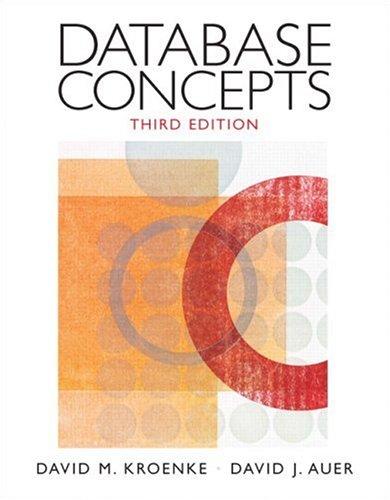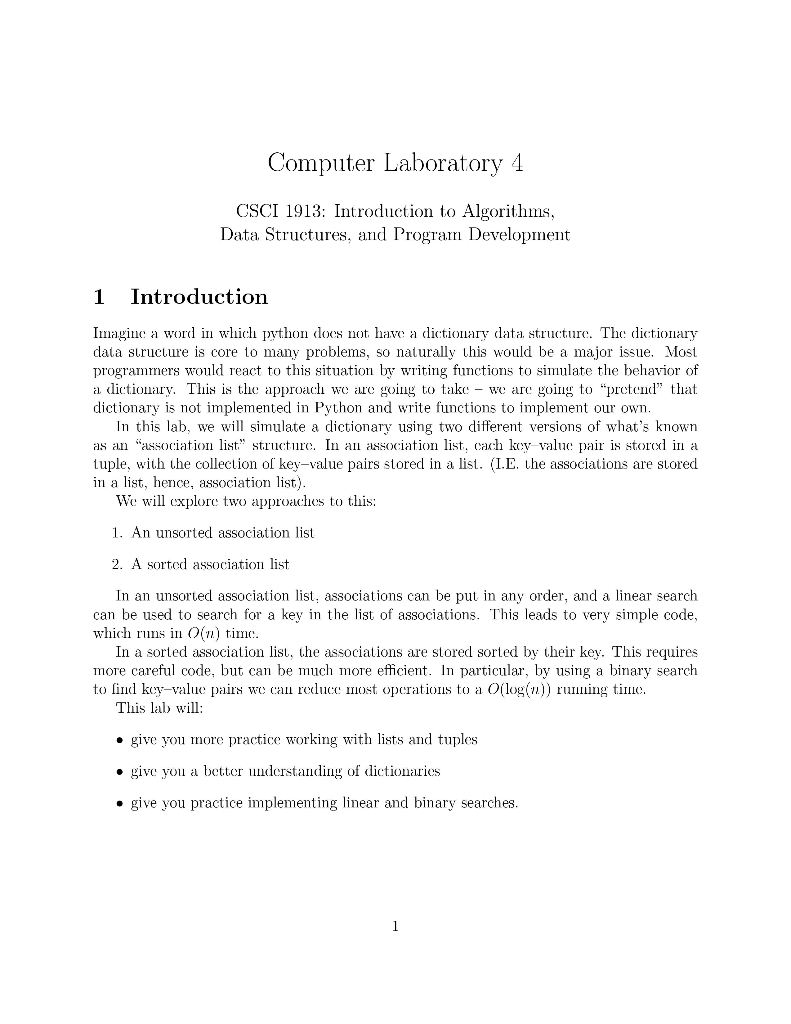
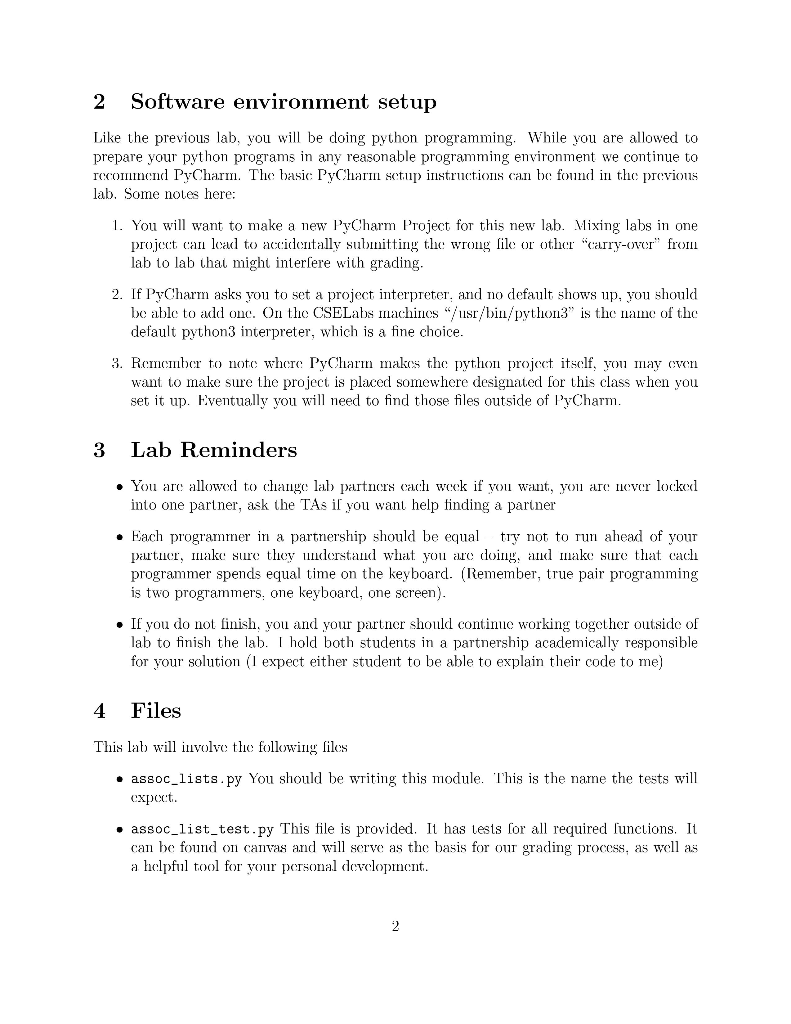
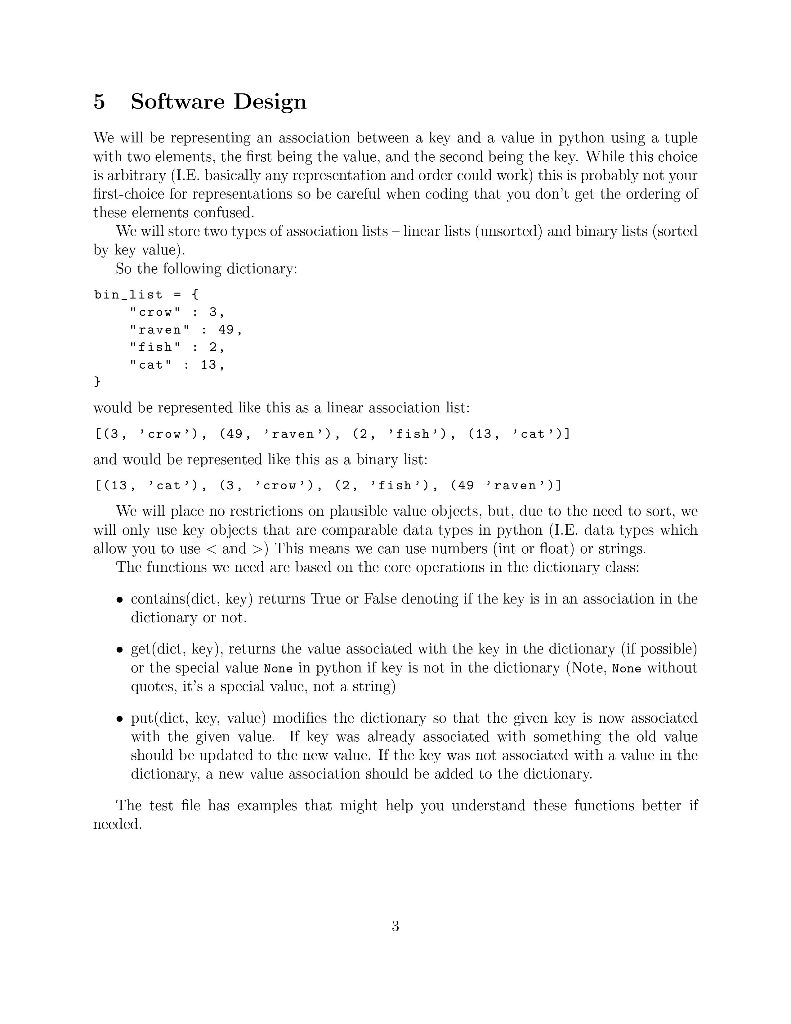
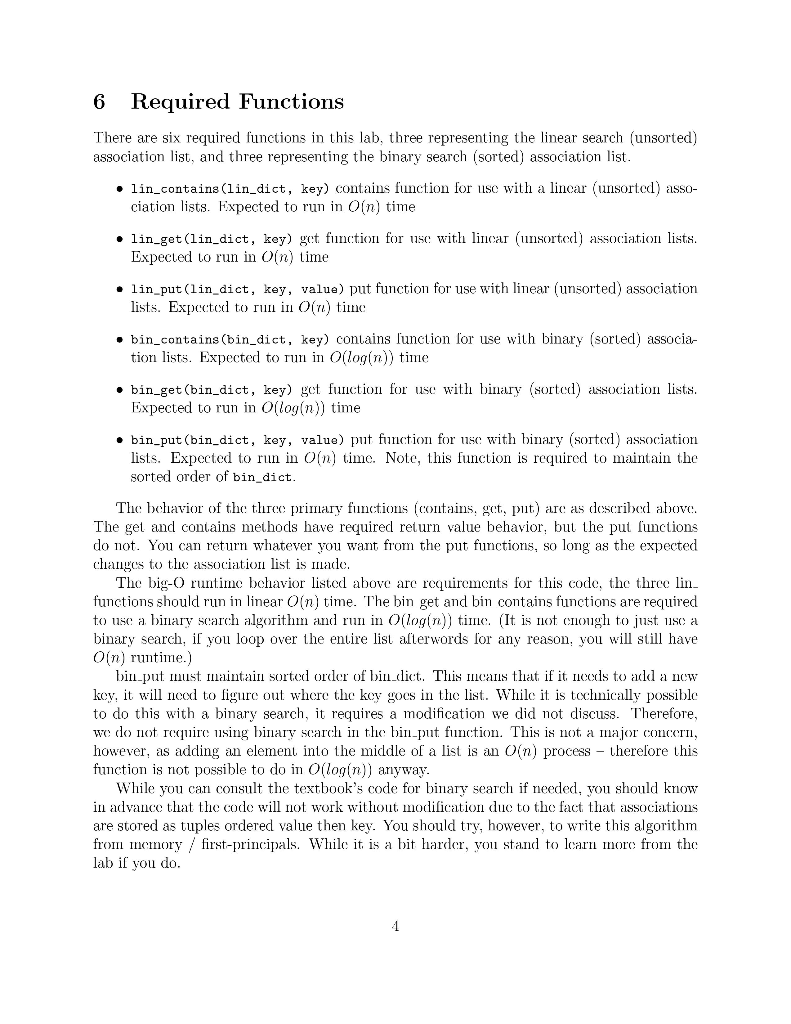

#
# Tests for required functions on lab 4
# DANIEL KLUVER 16 Feb 2020
#
# Each test has a comment showing what output is expected.
# In general, each test will be around 2 points each.
from assoc_lists import *
# Linear association list tests:
empty = []
lin_list_num = [("word", 3.14), ("reason", 1.23), ("candy", 5), ("fault", 4.1)]
# The lin_list is equivalent to this: {3:"word", 1:"reason", 5:"candy", 4:"fault"}
# Note, we can use any "sortable" data for keys, so any number or strings.
print(lin_contains(lin_list_num, 3.14)) # True
print(lin_contains(lin_list_num, 4.126)) # False
print(lin_contains(empty, 3.14)) # False
print(lin_get(empty, 1.23)) # None
print(lin_get(lin_list_num, 53.2)) # None
print(lin_get(lin_list_num, 3.14)) # word
print(lin_get(lin_list_num, 5)) # candy
print(lin_get(lin_list_num, 4.1)) # fault
lin_put(empty, "apple", "dog")
print(empty) # [("dog", "apple")]
lin_put(lin_list_num, 5, "sugar")
print(len(lin_list_num)) # 4
print( ("sugar", 5) in lin_list_num) # True
print(lin_get(lin_list_num, 5)) # sugar
lin_put(lin_list_num, 10.3, "flood")
print(len(lin_list_num)) # 5
print( ("flood", 10.3) in lin_list_num) # True
# BINARY SEAR ASSOCIATION TESTS
print("BINARY")
empty = []
#bin_list = {
# "crow" : 3,
# "raven" : 49,
# "fish" : 2,
# "cat" : 13,
# "dog" : 52,
# "zebra" : 13,
# "whale" : 11.3,
# "emu" : 56
#}
# note that python let's us use so no issue here.
bin_list = [(13, 'cat'), (3, 'crow'), (52, 'dog'), (56, 'emu'), (2, 'fish'), (49,
'raven'), (11.3, 'whale'), (41, 'zebra')]
print(bin_contains(empty, "dog")) # False
print(bin_contains(bin_list, "apple")) # False
print(bin_contains(bin_list, "dragon")) # False
print(bin_contains(bin_list, "zzz")) # False
print(bin_contains(bin_list, "cat")) # True
print(bin_contains(bin_list, "fish")) # True
print(bin_contains(bin_list, "zebra")) # True
print(bin_get(empty, "dog")) # None
print(bin_get(bin_list, "apple")) # None
print(bin_get(bin_list, "dragon")) # None
print(bin_get(bin_list, "zzz")) # None
print(bin_get(bin_list, "cat")) # 13
print(bin_get(bin_list, "whale")) # 11.3
print(bin_get(bin_list, "zebra")) # 41
bin_put(empty, "apple", "dog")
print(empty) # [("dog", "apple")]
bin_list = [(13, 'cat'), (3, 'crow'), (52, 'dog'), (56, 'emu'), (2, 'fish'), (49,
'raven'), (11.3, 'whale'), (41, 'zebra')]
bin_put(bin_list, "cat", 99)
print(bin_get(bin_list, "cat")) # 99
print(len(bin_list)) # 8
print(bin_list[0]) # (99, 'cat')
bin_list = [(13, 'cat'), (3, 'crow'), (52, 'dog'), (56, 'emu'), (2, 'fish'), (49,
'raven'), (11.3, 'whale'), (41, 'zebra')]
bin_put(bin_list, "zebra", 99)
print(bin_get(bin_list, "zebra")) # 99
print(len(bin_list)) # 8
print(bin_list[7]) # (99, 'zebra')
bin_list = [(13, 'cat'), (3, 'crow'), (52, 'dog'), (56, 'emu'), (2, 'fish'), (49,
'raven'), (11.3, 'whale'), (41, 'zebra')]
bin_put(bin_list, "dog", 99)
print(bin_get(bin_list, "dog")) # 99
print(len(bin_list)) # 8
print(bin_list[2]) # (99, 'dog')
bin_list = [(13, 'cat'), (3, 'crow'), (52, 'dog'), (56, 'emu'), (2, 'fish'), (49,
'raven'), (11.3, 'whale'), (41, 'zebra')]
bin_put(bin_list, "apple", 99)
print(bin_get(bin_list, "apple")) # 99
print(len(bin_list)) # 9
print(bin_list[0]) # (99, 'apple')
bin_list = [(13, 'cat'), (3, 'crow'), (52, 'dog'), (56, 'emu'), (2, 'fish'), (49,
'raven'), (11.3, 'whale'), (41, 'zebra')]
bin_put(bin_list, "zzzzz", 99)
print(bin_get(bin_list, "zzzzz")) # 99
print(len(bin_list)) # 9
print(bin_list[-1]) # (99, 'zzzzz')
bin_list = [(13, 'cat'), (3, 'crow'), (52, 'dog'), (56, 'emu'), (2, 'fish'), (49,
'raven'), (11.3, 'whale'), (41, 'zebra')]
bin_put(bin_list, "dragon", 99)
print(bin_get(bin_list, "dragon")) # 99
print(len(bin_list)) # 9
print(bin_list[3]) # (99, 'dragon')
The stuff at the bottom are the test files.
A general solution for the lab is fine.
Computer Laboratory 4 CSCI 1913: Introduction to Algorithms, Data Structures, and Program Development 1 Introduction Imagine a word in which python does not have a dictionary data structure. The dictionary data structure is core to many problems, so naturally this would be a major issue. Most programmers would react to this situation by writing functions to simulate the behavior of a dictionary. This is the approach we are going to take - we are going to "pretend" that dictionary is not implemented in Python and write functions to implement our own. In this lab, we will simulate a dictionary using two different versions of what's known as an "association list" structure. In an association list, cach koy value pair is stored in a tuple, with the collection of key-value pairs stored in a list. (I.E. the associations are stored in a list, hence, association list). We will explore two approaches to this: 1. An unsorted association list 2. A sorted association list In an unsorted association list, associations can be put in any order, and a linear search can be used to search for a key in the list of associations. This leads to very simple code, which runs in O(.) time. In a sorted association list, the associations are stored sorted by their key. This requires more careful code, but can be much more efficient. In particular, by using a binary search to find key-value pairs we can reduce most operations to a O(log(n)) ruming time. This lal) will: give you more practice working with lists and tuples give you a better understanding of dictionaries give you practice implementing linear and binary searches. 2 Software environment setup Like the previous lab, you will be doing python programming. While you are allowed to prepare your python programs in any reasonable programming environment we continue to recommend PyCharm. The basic PyCharil stup instructions can be found in the previous lab. Some notes here: 1. You will want to make a new PyCharm Project for this new lab. Mixing labs in one project can lead to accidentally submitting the wrong file or other "carry-over" from lab to lab thai might interfere with grading. 2. If PyCharm asks you to set a project interpreter, and no default shows up, you should be able to add onc. On the CSELabs machines "/usr/bin/python3" is the name of the default python3 interpreter, which is a fine choice. 3. Remember to note where PyCharn makes the python project itself, you may even want to make sure the project is placed somewhere designated for this class when you set it up. Eventually you will need to find those files outside of lyCharm. 3 Lab Reminders You are allowed to change lab partners cach weck if you want, you are never locked into one partner, ask the TAs if you want help finding a partner Each programmer in a partnership should be equal try not to run ahead of your partier, make sure they understand what you are doing, and make sure that caci programmer spends equal time on the keyboard. (Remember, true pair programming is two programmers, one keyboard, one screen). . If you do not finish, you and your partner should continue working together outside of lab to finish the lab. I hold both students in a partnership academically responsible for your solution (1 expect either student to be able to explain their code to me) 4 Files This lab will involve the following files assoc_lists.py You should be writing this module. This is the name the tests will cxpect. assoc_list_test.py This file is provided. It has lests for all required functions. It can be found on canvas and will serve as the basis for our grading process, as well as a helpful tool for your personal development. 5 Software Design We will be representing an association between a key and a value in python using a tuple with two elements, the first being the value, and the second being the key. While this choice is arbitrary (I.E. basically any representation and order could work) this is probably not your first choice for representations so be careful when coding that you don't get the ordering of these elements confused. We will store two types of association lists - lincar lists (unsorted) and binary lists (sorted by key value). So the following dictionary: bin_list = { "crow" : 3, "raven" : 49, "fish" : 2, "cat" : 13, would be represented like this as a linear association list: [(3, crow'), (49, 'raven'), (2, 'fish'), (13, 'cat')] and would be represented like this as a binary list: [(13, 'cat'), (3, crow'), (2, 'fish'), (49 'raven')] We will place no restrictions on plausible value objects, but, due to the need to sort, we will only use key objects that are comparable data types in python (I.E. data types which allow you to use ) This means we can use numbers (int or float) or strings. The functions we need are based on the core operations in the dictionary class: contains(dict, key) returns True or False denoting i the key is in an association in the dictionary or not. .get(dict, key), returns the value associated with the key in the dictionary (il possible) or the special value None in python if key is not in the dictionary (Note, None without quotes, it's a special valuc, not a string) put(dict, key value) modifics the dictionary so that the given key is now associated with the given value. If key was already associated with something the old value should be updated to the new value. If the key was not associated with a value in the dictionary, a new value association should be added to the dictionary. The test file has examples that might help you understand these functions better if Ilcole. 6 Required Functions There are six required functions in this lab, three representing the linear search (unsorted) association list, and three representing the binary search (sorted) association list. lin_contains (lin_dict, key) contains function for use with a lincar (unsorted) asso- ciation lists. Expected to run in O(n) time lin-get(lin_dict, key) get function for use with linicar (insorted) association lists. Expected to run in Oin) lime lin_put(lin_dict, key, value) put function for use with linear (unsorted) association lists. Expected to run in O(nl) time bin_contains (bin_dict, key) contains lunction for use with binary (sorted) associa- tion lists. Expected to run in O(login)) time bin_get(bin_dict, key) yet function for use with binary (sorted) association lists. Expected to run in O(login)) time bin_put (bin_dict, key, value) put function for use with binary (sorted) association lists. Expected to run in On) time. Note, this function is required to maintain the sorted order of bin_dict. The behavior of the three primary functions contains, get, put) arc as described above. The get and contains methods have required return value behavior, but the put functions do not. You can return whatever you want from the put functions, so long as the expected changes to the association list is made. The big-O runtime behavior listed above are requirements for this code, the three lin_ functions should run in linear O(n) time. The bin get and bin contains functions are required to use a binary scarch algorithm and run in O(login)) time. (It is not crough to just usca binary search, if you loop over the entire list afterwords for any reason, you will still have Oin) runtime.) bin_put must maintaill sorted order of bin_dict. This incans that if it iices to add a new key, it will need to figure out where the key goes in the list. While it is tochnically possible to do this with a binary search, it requires a modification we did not discuss. Therefore, we do not require using binary scarch in the birl-put function. This is not a major concerti, however, as adding an element into the middle of a list is an O(n) process - therelore this function is not possible to do in O(login)) anyway. While you can consult the textbook's code for binary search if needed, you should know in advance that the code will not work without modification due to the fact that associations are stored as tuples ordered value then key. You should try, however, to write this algorithm from memory first-principals. While it is a bit harder, vou stand to learn more from the lab i you do. 7 Deliverable Before submitting your work, please use the tests to carefully check that your code is bug- free, and has every function named as expected, and returning data types compatible with our expectations. Name your submission file assoc_lists.py and make sure that a comment at the top has your name, and if you worked with a partner, your partner's name. If you worked without a partner and their name is not on your file they will not get credit, OR, you will be accused of cheating (depending on if they turn in the file or not) You should only submit the assoc_lists.py file. You will submit this through canvas. If you worked with a lab partner, BOTH STUDENTS SHOULD SUBMIT A COPY. This is different than previous weeks, we believe it will be easier to grade submissions quickly if each student turns in their own copy. EVERY STUDENT IS EXPECTED TO SUBMIT A COPY OF THE LAB! Evcil if they worked with a partner. It is OK if you and your partner submit the Saline ile. We just want everyone to have a file submitted. This will be duc before the beginning of your next lab next week. The exact time will be based on the official start time of your lab. Canvas will accept re-submissions, and will also accept late submissions. Please be sure you do not turn in the assignment late on accident. If you finish this lab during the lab time, feel free to notify your lab TAs, and then leave carly. If you do not finish this lab during the lab time you are responsible for finishing before the next lab. Computer Laboratory 4 CSCI 1913: Introduction to Algorithms, Data Structures, and Program Development 1 Introduction Imagine a word in which python does not have a dictionary data structure. The dictionary data structure is core to many problems, so naturally this would be a major issue. Most programmers would react to this situation by writing functions to simulate the behavior of a dictionary. This is the approach we are going to take - we are going to "pretend" that dictionary is not implemented in Python and write functions to implement our own. In this lab, we will simulate a dictionary using two different versions of what's known as an "association list" structure. In an association list, cach koy value pair is stored in a tuple, with the collection of key-value pairs stored in a list. (I.E. the associations are stored in a list, hence, association list). We will explore two approaches to this: 1. An unsorted association list 2. A sorted association list In an unsorted association list, associations can be put in any order, and a linear search can be used to search for a key in the list of associations. This leads to very simple code, which runs in O(.) time. In a sorted association list, the associations are stored sorted by their key. This requires more careful code, but can be much more efficient. In particular, by using a binary search to find key-value pairs we can reduce most operations to a O(log(n)) ruming time. This lal) will: give you more practice working with lists and tuples give you a better understanding of dictionaries give you practice implementing linear and binary searches. 2 Software environment setup Like the previous lab, you will be doing python programming. While you are allowed to prepare your python programs in any reasonable programming environment we continue to recommend PyCharm. The basic PyCharil stup instructions can be found in the previous lab. Some notes here: 1. You will want to make a new PyCharm Project for this new lab. Mixing labs in one project can lead to accidentally submitting the wrong file or other "carry-over" from lab to lab thai might interfere with grading. 2. If PyCharm asks you to set a project interpreter, and no default shows up, you should be able to add onc. On the CSELabs machines "/usr/bin/python3" is the name of the default python3 interpreter, which is a fine choice. 3. Remember to note where PyCharn makes the python project itself, you may even want to make sure the project is placed somewhere designated for this class when you set it up. Eventually you will need to find those files outside of lyCharm. 3 Lab Reminders You are allowed to change lab partners cach weck if you want, you are never locked into one partner, ask the TAs if you want help finding a partner Each programmer in a partnership should be equal try not to run ahead of your partier, make sure they understand what you are doing, and make sure that caci programmer spends equal time on the keyboard. (Remember, true pair programming is two programmers, one keyboard, one screen). . If you do not finish, you and your partner should continue working together outside of lab to finish the lab. I hold both students in a partnership academically responsible for your solution (1 expect either student to be able to explain their code to me) 4 Files This lab will involve the following files assoc_lists.py You should be writing this module. This is the name the tests will cxpect. assoc_list_test.py This file is provided. It has lests for all required functions. It can be found on canvas and will serve as the basis for our grading process, as well as a helpful tool for your personal development. 5 Software Design We will be representing an association between a key and a value in python using a tuple with two elements, the first being the value, and the second being the key. While this choice is arbitrary (I.E. basically any representation and order could work) this is probably not your first choice for representations so be careful when coding that you don't get the ordering of these elements confused. We will store two types of association lists - lincar lists (unsorted) and binary lists (sorted by key value). So the following dictionary: bin_list = { "crow" : 3, "raven" : 49, "fish" : 2, "cat" : 13, would be represented like this as a linear association list: [(3, crow'), (49, 'raven'), (2, 'fish'), (13, 'cat')] and would be represented like this as a binary list: [(13, 'cat'), (3, crow'), (2, 'fish'), (49 'raven')] We will place no restrictions on plausible value objects, but, due to the need to sort, we will only use key objects that are comparable data types in python (I.E. data types which allow you to use ) This means we can use numbers (int or float) or strings. The functions we need are based on the core operations in the dictionary class: contains(dict, key) returns True or False denoting i the key is in an association in the dictionary or not. .get(dict, key), returns the value associated with the key in the dictionary (il possible) or the special value None in python if key is not in the dictionary (Note, None without quotes, it's a special valuc, not a string) put(dict, key value) modifics the dictionary so that the given key is now associated with the given value. If key was already associated with something the old value should be updated to the new value. If the key was not associated with a value in the dictionary, a new value association should be added to the dictionary. The test file has examples that might help you understand these functions better if Ilcole. 6 Required Functions There are six required functions in this lab, three representing the linear search (unsorted) association list, and three representing the binary search (sorted) association list. lin_contains (lin_dict, key) contains function for use with a lincar (unsorted) asso- ciation lists. Expected to run in O(n) time lin-get(lin_dict, key) get function for use with linicar (insorted) association lists. Expected to run in Oin) lime lin_put(lin_dict, key, value) put function for use with linear (unsorted) association lists. Expected to run in O(nl) time bin_contains (bin_dict, key) contains lunction for use with binary (sorted) associa- tion lists. Expected to run in O(login)) time bin_get(bin_dict, key) yet function for use with binary (sorted) association lists. Expected to run in O(login)) time bin_put (bin_dict, key, value) put function for use with binary (sorted) association lists. Expected to run in On) time. Note, this function is required to maintain the sorted order of bin_dict. The behavior of the three primary functions contains, get, put) arc as described above. The get and contains methods have required return value behavior, but the put functions do not. You can return whatever you want from the put functions, so long as the expected changes to the association list is made. The big-O runtime behavior listed above are requirements for this code, the three lin_ functions should run in linear O(n) time. The bin get and bin contains functions are required to use a binary scarch algorithm and run in O(login)) time. (It is not crough to just usca binary search, if you loop over the entire list afterwords for any reason, you will still have Oin) runtime.) bin_put must maintaill sorted order of bin_dict. This incans that if it iices to add a new key, it will need to figure out where the key goes in the list. While it is tochnically possible to do this with a binary search, it requires a modification we did not discuss. Therefore, we do not require using binary scarch in the birl-put function. This is not a major concerti, however, as adding an element into the middle of a list is an O(n) process - therelore this function is not possible to do in O(login)) anyway. While you can consult the textbook's code for binary search if needed, you should know in advance that the code will not work without modification due to the fact that associations are stored as tuples ordered value then key. You should try, however, to write this algorithm from memory first-principals. While it is a bit harder, vou stand to learn more from the lab i you do. 7 Deliverable Before submitting your work, please use the tests to carefully check that your code is bug- free, and has every function named as expected, and returning data types compatible with our expectations. Name your submission file assoc_lists.py and make sure that a comment at the top has your name, and if you worked with a partner, your partner's name. If you worked without a partner and their name is not on your file they will not get credit, OR, you will be accused of cheating (depending on if they turn in the file or not) You should only submit the assoc_lists.py file. You will submit this through canvas. If you worked with a lab partner, BOTH STUDENTS SHOULD SUBMIT A COPY. This is different than previous weeks, we believe it will be easier to grade submissions quickly if each student turns in their own copy. EVERY STUDENT IS EXPECTED TO SUBMIT A COPY OF THE LAB! Evcil if they worked with a partner. It is OK if you and your partner submit the Saline ile. We just want everyone to have a file submitted. This will be duc before the beginning of your next lab next week. The exact time will be based on the official start time of your lab. Canvas will accept re-submissions, and will also accept late submissions. Please be sure you do not turn in the assignment late on accident. If you finish this lab during the lab time, feel free to notify your lab TAs, and then leave carly. If you do not finish this lab during the lab time you are responsible for finishing before the next lab











